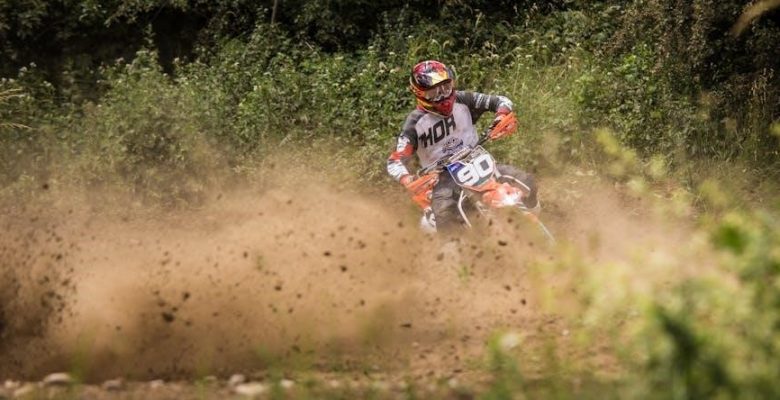manual dirt bike
A manual dirt bike offers thrilling off-road adventures‚ requiring coordination and skill to operate․ It features a clutch and gear system‚ allowing riders to control speed and torque‚ making it ideal for both recreational and competitive riding․
What is a Manual Dirt Bike?
A manual dirt bike is a type of off-road motorcycle equipped with a manual transmission system‚ requiring riders to operate a clutch and gear shifter․ Unlike automatic dirt bikes‚ manual bikes demand active engagement‚ as riders must coordinate the clutch‚ throttle‚ and gear shifting to control speed and torque․ These bikes are designed for off-road adventures‚ featuring lightweight frames‚ robust engines‚ and durable tires tailored for rough terrain․ The manual system allows precise control‚ making it ideal for motocross racing‚ trail riding‚ and technical off-road challenges․ Learning to ride a manual dirt bike requires practice‚ as it involves mastering the clutch-gear coordination‚ but it offers a rewarding experience for enthusiasts seeking ultimate control and connection with their bike․
Why Learn to Ride a Manual Dirt Bike?
Riding a manual dirt bike offers a rewarding experience that combines skill mastery with outdoor adventures․ It requires coordination of clutch and gear shifting‚ enhancing control and connection with the bike․ Many riders start with manual dirt bikes to progress to larger bikes or competitions‚ as it builds foundational skills․ The challenge of learning is appealing for those who enjoy personal growth and mechanical engagement․ With available online tutorials and professional courses‚ mastering a manual dirt bike is achievable and opens doors to more challenging and enjoyable riding experiences․
Key Components of a Manual Dirt Bike
A manual dirt bike features essential components that enable its operation․ The clutch lever‚ located on the left handlebar‚ controls gear engagement․ The gear shifter‚ positioned on the left footpeg‚ allows riders to shift gears․ The engine provides power‚ while the suspension system absorbs shocks for a smoother ride․ Durable off-road tires ensure traction on various terrains․ The handlebars offer control for steering‚ and the footpegs provide rider stability․ Understanding these components is crucial for effective riding and maintenance‚ ensuring optimal performance and safety during off-road adventures․
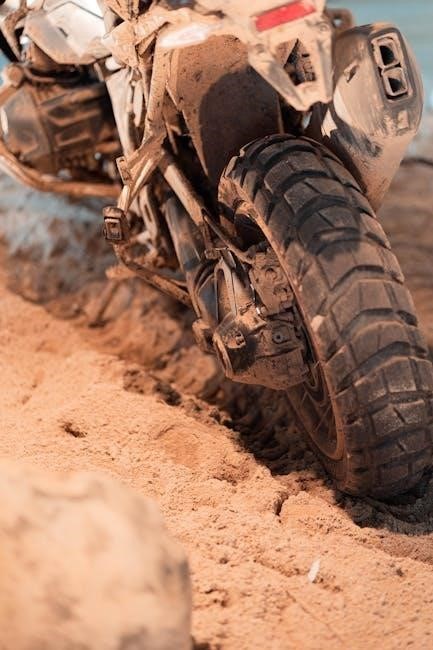
Understanding the Clutch and Gear System
The clutch and gear system are central to controlling a manual dirt bike․ The clutch lever‚ located on the left handlebar‚ disengages the engine from the gearbox‚ allowing smooth gear shifts․ The gear shifter‚ positioned on the left footpeg‚ enables riders to transition between gears‚ optimizing speed and torque for various terrains and conditions․
How the Clutch Works
The clutch on a manual dirt bike operates by disconnecting the engine from the transmission‚ allowing riders to shift gears seamlessly․ Located on the left handlebar‚ the clutch lever engages a mechanical system that separates the engine’s power from the rear wheel when pulled in․ This disconnection is essential for smooth gear transitions‚ preventing the bike from stalling or jerking during shifts․ When the lever is released‚ the clutch re-engages‚ transferring power back to the gearbox and wheels․ Proper use of the clutch is critical for maintaining control‚ especially during starts and stops‚ and ensures efficient acceleration and maneuverability on various terrains․
Location and Function of the Gear Shifter
The gear shifter on a manual dirt bike is located on the left side of the bike‚ near the footpeg․ Its primary function is to manually change gears by pressing down with the foot․ The shifter is connected to the transmission‚ allowing riders to select the appropriate gear for their speed and terrain․ To shift gears‚ the rider must first pull in the clutch‚ then press the shifter down or up to change gears․ The gear shifter plays a crucial role in controlling the bike’s acceleration and torque‚ ensuring smooth transitions between gears for optimal performance․ Proper use of the shifter enhances control and riding efficiency․
Neutral Gear and Its Importance
Neutral gear is a fundamental feature of a manual dirt bike‚ allowing the bike to remain stationary without engaging the engine․ Located between first and second gears‚ neutral is essential for starting the bike and preparing to ride․ When in neutral‚ the bike does not move‚ even with the engine running‚ providing a safe position for starting or stopping․ Proper use of neutral prevents accidental movement and reduces the risk of stalling․ It also allows riders to pause momentarily without turning off the engine‚ making it a crucial component for both new and experienced riders to master for safe and effective operation․
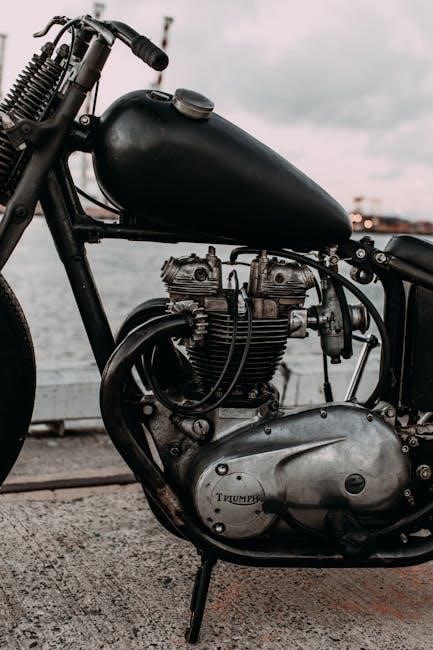
Basic Steps to Ride a Manual Dirt Bike
Pull in the clutch‚ shift into first gear‚ and release the clutch while gently accelerating․ This sequence helps maintain control and ensures a smooth start․
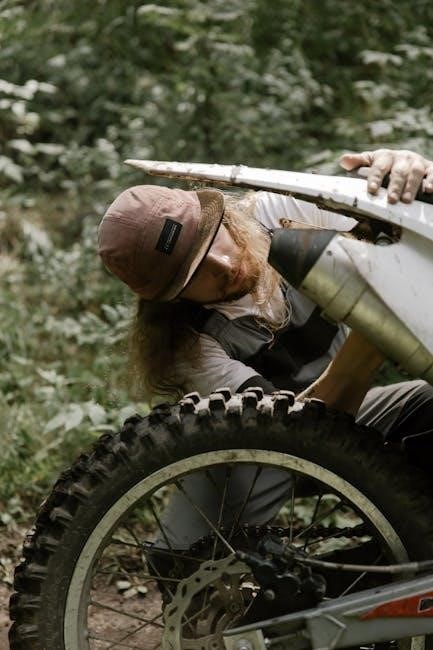
Starting the Bike
Starting a manual dirt bike begins with ensuring it is in neutral gear․ Pull in the clutch lever fully and press the ignition button to start the engine․ Once the bike is running‚ release the clutch slowly while giving a small amount of throttle to avoid stalling․ Always wear proper safety gear and ensure the area is clear before starting․ If the bike doesn’t start immediately‚ check the fuel and ensure the choke is in the correct position․ Proper starting technique is crucial for a smooth ride and prevents unnecessary wear on the engine and clutch system․
Shifting into First Gear
Shifting into first gear on a manual dirt bike is a straightforward process․ With the bike in neutral and the clutch pulled in‚ locate the gear shifter on the left foot peg․ Firmly press the shifter down with your foot until you feel the gear engage․ You may hear a slight click‚ confirming the shift․ Slowly release the clutch while simultaneously applying gentle throttle to avoid stalling․ Ensure your weight is centered and your body is balanced for optimal control․ Proper gear engagement is essential for smooth acceleration and maintaining traction‚ especially when starting from a standstill or navigating challenging terrain․
Releasing the Clutch and Accelerating
Releasing the clutch and accelerating is a critical step in mastering a manual dirt bike․ After shifting into first gear‚ gradually release the clutch lever while simultaneously applying gentle to moderate throttle․ This smooth action prevents stalling and ensures the bike moves forward evenly․ As you feel the bike begin to engage‚ maintain balance by keeping your weight centered and your knees gripping the tank․ Avoid sudden jerks or aggressive acceleration‚ especially for beginners‚ to maintain control․ Proper coordination between clutch release and throttle input is key to a smooth start and building confidence in your riding skills․
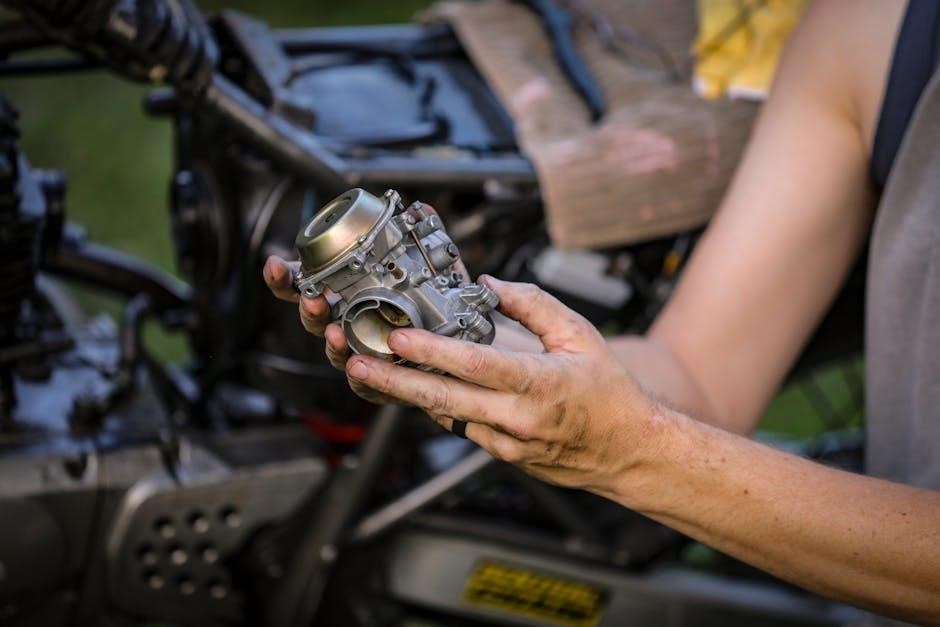
Mastering Gear Shifting Techniques
Mastering gear shifting on a manual dirt bike enhances ride control and performance․ Smooth transitions between gears improve speed management and overall riding efficiency‚ ensuring a seamless experience․
When to Shift Gears
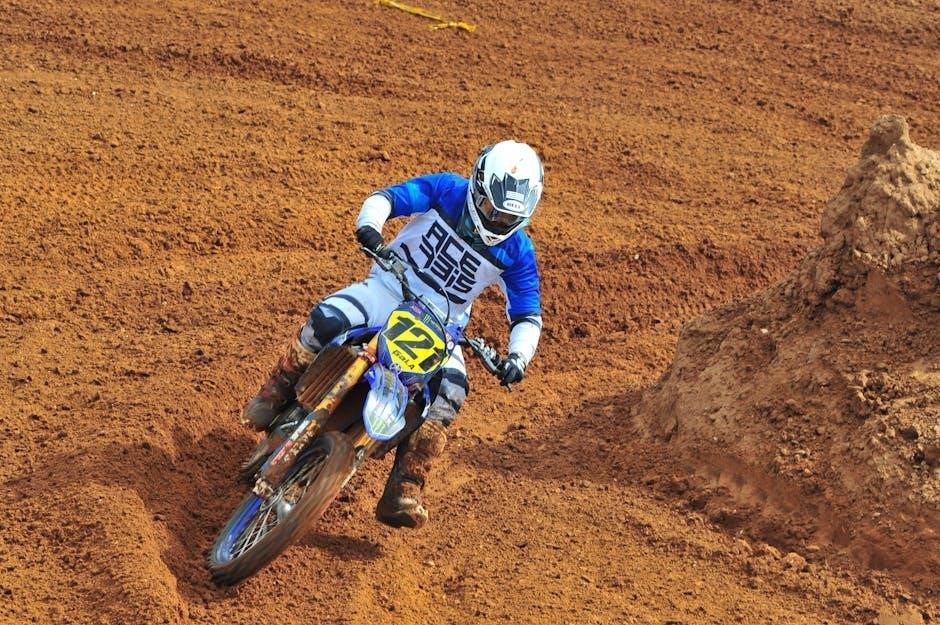
Knowing when to shift gears is crucial for smooth control of a manual dirt bike․ Shift up when the engine RPM increases and you need more speed‚ typically when accelerating on straight paths or uphill․ Downshift before decelerating or approaching turns to maintain control and avoid skidding․ Proper timing ensures optimal power delivery and stability‚ making the ride safer and more enjoyable․ Pay attention to engine sound and terrain changes to determine the right moments to shift․ Practice in safe environments to develop muscle memory and improve your shifting technique over time․
How to Shift Gears Smoothly
Shifting gears smoothly on a manual dirt bike requires coordination between the clutch‚ throttle‚ and gear shifter․ Always pull in the clutch fully before shifting to avoid grinding gears․ Use your foot to press the shifter firmly and deliberately‚ ensuring it clicks into place․ As you release the clutch‚ gradually apply throttle to maintain momentum and avoid jerking․ Practice in a safe‚ open area to develop muscle memory and refine your technique․ Smooth shifts enhance control‚ reduce wear on the bike‚ and make the ride more enjoyable․ Consistent practice will help you master this essential skill․
Downshifting and Engine Braking
Downshifting and engine braking are crucial techniques for controlling speed on a manual dirt bike․ Downshifting involves shifting to a lower gear before decelerating‚ which helps maintain control and prevents wheel lock-up․ Engine braking uses the engine’s compression to slow the bike by closing the throttle and downshifting․ Proper timing is essential; downshift before entering turns or descending hills to avoid losing traction․ This method reduces brake wear and improves stability․ Practice downshifting smoothly to avoid abrupt jerks․ Mastering these skills enhances overall control and safety‚ especially in challenging terrain․ Effective use of engine braking and downshifting is key to confident and precise riding․

Body Positioning and Control
Body positioning is crucial for control and stability on a manual dirt bike․ Proper posture‚ weight distribution‚ and steering techniques enhance balance and maneuverability in various terrains․
Proper Sitting and Standing Posture
Proper posture on a manual dirt bike is essential for balance and control․ When sitting‚ keep your knees slightly bent‚ gripping the tank with your legs‚ and your weight centered․ Stand with knees bent‚ elbows relaxed‚ and weight slightly forward․ This stance improves stability and allows for better maneuvering on uneven terrain․ Maintaining proper posture helps in absorbing shocks and making precise turns․ Always keep your head up and eyes focused on the path ahead to anticipate obstacles and maintain direction․ Correct posture reduces fatigue and enhances overall riding performance‚ whether cruising or tackling challenging trails․
Weight Distribution for Stability
Proper weight distribution is crucial for maintaining stability on a manual dirt bike․ Shift your weight slightly forward when accelerating or riding on flat terrain to improve control and reduce rear-wheel skidding․ When climbing hills‚ move your weight backward to enhance rear-wheel traction and prevent the front wheel from lifting․ Standing on the foot pegs allows for better balance‚ as it enables you to shift your weight dynamically․ Keep your knees gripping the tank and your elbows slightly bent to absorb shocks and maintain stability․ Balanced weight distribution ensures better handling‚ reduces the risk of losing control‚ and enhances overall riding confidence and performance․ Always adjust your position according to terrain and speed for optimal stability․
Steering and Turning Techniques
Mastering steering and turning techniques is essential for controlling a manual dirt bike․ To initiate a turn‚ lean your body in the direction you want to go while angling the handlebars slightly․ Shift your weight to the foot peg on the same side as the turn to maintain balance and stability․ For sharper turns‚ use a combination of handlebar input and body positioning․ At higher speeds‚ subtle movements are key to avoid overcorrecting․ Countersteering‚ a quick flick of the handlebars in the opposite direction‚ can help stabilize the bike during fast turns․ Always keep your eyes focused on the path ahead to guide the bike effectively․ Practice these techniques in open spaces to build confidence and precision in your control․
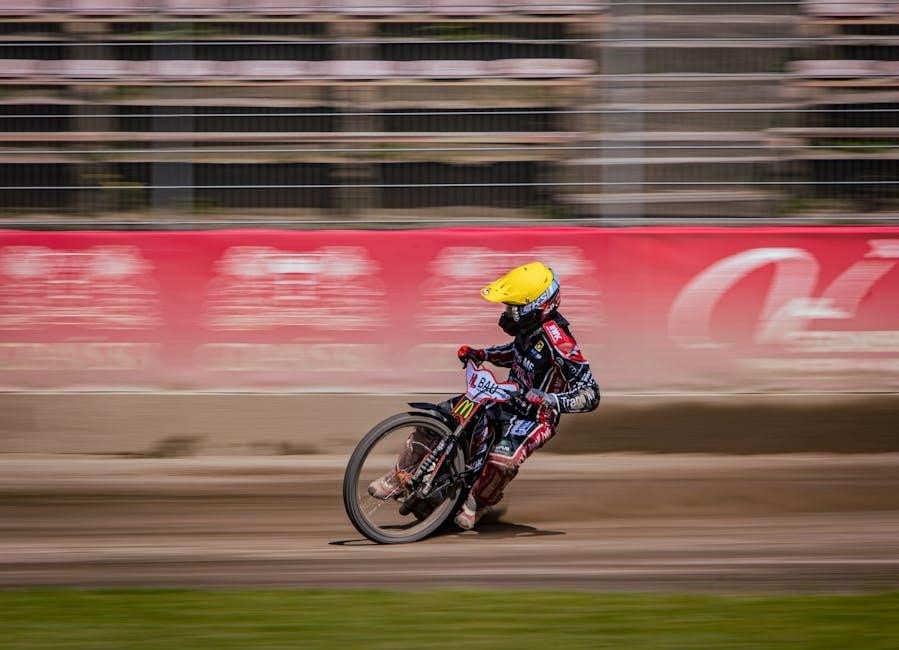
Maintenance Tips for a Manual Dirt Bike
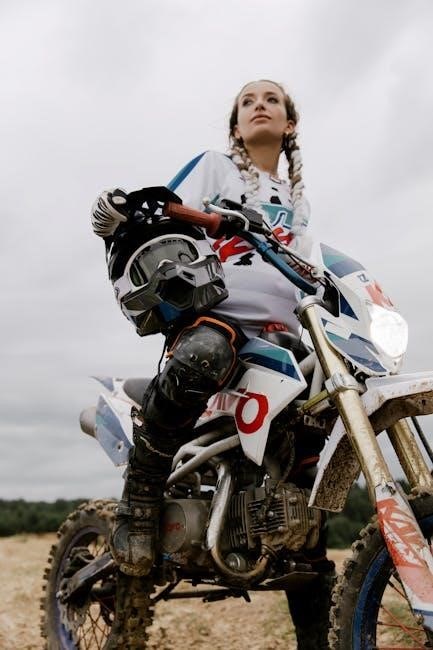
Regular maintenance ensures optimal performance and longevity․ Check and clean the air filter‚ inspect tires‚ and lubricate the chain․ Replace worn-out parts promptly to avoid damage․
Clutch Maintenance
Proper clutch maintenance is essential for smooth gear shifts and consistent performance․ Regularly clean the clutch lever and inspect for wear or damage․ Lubricate pivot points to ensure smooth operation․
- Check the clutch cable for fraying or tension issues․
- Replace worn-out clutch plates promptly to avoid further damage․
- Inspect the clutch basket for alignment and damage․
Regular maintenance prevents wear and tear‚ ensuring reliable performance and extending the lifespan of your manual dirt bike’s clutch system․
Checking and Replacing Gear Components
Regular inspection of gear components ensures optimal performance and safety․ Always check the gear shifter for proper alignment and wear․ Lubricate the shift mechanism to maintain smooth operation․
- Inspect gear teeth for signs of wear or damage․
- Replace damaged or worn gears promptly to prevent further issues․
- Ensure all bolts and fasteners are secure to maintain proper gear alignment․
Regular maintenance of gear components prevents mechanical failures and ensures smooth shifting‚ enhancing the overall riding experience of your manual dirt bike․
Regular Servicing for Optimal Performance
Regular servicing is crucial for maintaining the performance and longevity of a manual dirt bike․ Schedule routine checks to ensure all components function optimally․
- Change the oil and filter regularly to keep the engine clean and lubricated․
- Clean or replace the air filter to maintain proper airflow and combustion efficiency․
- Lubricate the chain and check its tension for smooth power delivery․
- Inspect and replace brake pads and fluids to ensure reliable stopping power․
By following a consistent maintenance routine‚ you can enhance your dirt bike’s performance‚ reduce wear and tear‚ and enjoy a safer‚ more enjoyable riding experience․

Safety Precautions and Best Practices
Always wear protective gear‚ including a helmet‚ gloves‚ and boots․ Ride in safe‚ open areas and avoid hazards․ Stay alert and follow basic safety guidelines to minimize risks․
Essential Safety Gear
Protective gear is crucial when riding a manual dirt bike․ A helmet is mandatory to safeguard the head‚ while goggles protect the eyes from debris․ Durable gloves prevent blisters and improve grip‚ and sturdy boots with ankle support are essential for foot protection․ Additionally‚ consider wearing knee and elbow pads to shield joints from impact․ A chest protector or motocross jersey can provide further coverage․ Ensuring all gear fits properly enhances safety and comfort․ Always prioritize high-quality‚ durable equipment to minimize injury risks and enjoy a secure riding experience․
Riding in Safe Environments
Riding a manual dirt bike in a safe environment is essential for minimizing risks․ Choose open‚ flat areas free from obstacles like rocks‚ trees‚ or uneven terrain․ Avoid riding near roads or crowded spaces to reduce collision hazards․ Always inspect the area for potential dangers‚ such as loose debris or steep slopes․ Opt for designated dirt bike tracks or trails‚ as they are designed for off-road riding and often have safety features․ Stay aware of your surroundings‚ including other riders or wildlife‚ to ensure a safe and enjoyable experience․ Familiarizing yourself with the terrain beforehand can also help prevent accidents․
Avoiding Common Mistakes
When learning to ride a manual dirt bike‚ avoiding common mistakes is crucial for safety and progress․ One of the most frequent errors is improper use of the clutch‚ such as releasing it too quickly‚ which can cause the bike to stall․ Another mistake is failing to shift gears at the right moments‚ leading to loss of control or engine strain․ Riders should also avoid over-revving the engine in higher gears‚ as this can damage the motor․ Additionally‚ poor body positioning‚ such as leaning back or sitting too far forward‚ can affect balance and stability․ Being mindful of these pitfalls helps ensure a smoother and safer learning experience․
Learning Resources and Further Guidance
Online tutorials and videos provide step-by-step guidance‚ while professional training courses offer hands-on experience․ Community forums and expert advice help refine skills and address specific challenges․
Online Tutorials and Videos
Online tutorials and videos are excellent resources for learning to ride a manual dirt bike․ They provide step-by-step guides‚ demonstrating how to coordinate clutch and gear use․ Many videos focus on basic techniques‚ such as starting the bike‚ shifting gears‚ and maintaining control․ Channels like The Mx Factory offer tips for smooth gear transitions and avoiding common mistakes․ These visual aids are particularly helpful for beginners‚ as they show real-time examples of proper body positioning and clutch operation․ Additionally‚ tutorials often cover advanced skills‚ such as downshifting and engine braking‚ to help riders improve their performance․ They are accessible‚ convenient‚ and cater to all skill levels‚ making them a valuable learning tool for mastering manual dirt bike riding․
Professional Training Courses
Professional training courses are an excellent way to learn how to ride a manual dirt bike․ These courses are conducted by experienced instructors who provide hands-on training and personalized feedback․ They cover essential skills such as clutch control‚ gear shifting‚ and body positioning․ Many programs are designed for beginners‚ focusing on building confidence and mastery of basic techniques․ Advanced riders can also benefit from courses that refine their skills for competitive racing or challenging terrain․ These structured learning environments ensure riders develop safe and effective riding habits․ By enrolling in a professional training course‚ riders can progress at their own pace and gain the expertise needed to handle a manual dirt bike with precision and confidence․
Community Forums and Expert Advice
Community forums and expert advice are invaluable resources for learning to ride a manual dirt bike․ Online forums like Reddit’s r/Dirtbikes and specialized motocross communities offer a wealth of knowledge‚ tips‚ and troubleshooting advice from experienced riders․ These platforms allow learners to ask questions‚ share experiences‚ and gain insights into mastering manual dirt bike techniques․ Additionally‚ many professional riders and coaches provide expert advice through tutorials‚ blogs‚ and videos‚ covering topics like clutch control‚ gear shifting‚ and body positioning․ Engaging with these resources can accelerate the learning process and help riders overcome common challenges․ They also foster a sense of camaraderie and support within the dirt biking community․
